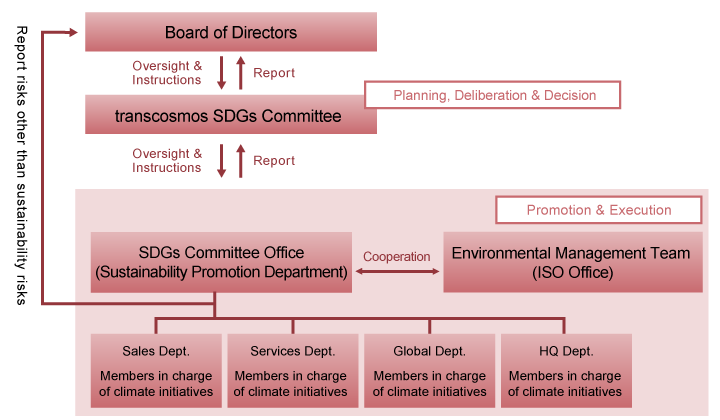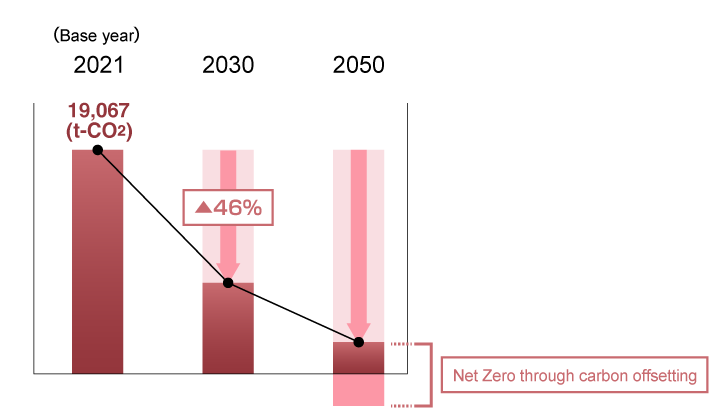Climate Change Initiatives
transcosmos has expressed its support for the Task Force on Climate-Related Financial Disclosure (TCFD*) Recommendations. Accordingly, we now disclose climate-related risks and revenue growth opportunities on the four items below in line with the TCFD recommendations.
【Disclosure Items】(Source: Ministry of the Environment: Practical guide for Scenario Analysis in line with the TCFD recommendations)
- 1. Governance: Disclose the organization’s governance around climate-related risks and opportunities
- 2. Strategy: Disclose the actual and potential impacts of climate-related risks and opportunities in the organization’s businesses, strategy, and financial planning where such information is material
- 3. Risk Management: Disclose how the organization identifies, assesses, and manages climate-related risks
- 4. Metrics and Targets: Disclose the metrics and targets used to assess and manage relevant climate-related risks and opportunities where such information is material
*transcosmos discloses information about 1. Governance and 3. Risk Management above together.
Governance / Risk Management
- At transcosmos, the transcosmos SDGs Committee, chaired by the Representative Director & Chairman, plans, deliberates and decides sustainability-related initiatives in line with our Fundamental Sustainability Policy. The committee members attend the Board of Directors meetings, and report status updates on key sustainability activities as well as other sustainability-related information to the board. The transcosmos SDGs Committee also discusses and decides material matters including response policies for climate-related risks and revenue growth opportunities, greenhouse gas emissions (GHG) targets, and initiatives towards the goal to reduce emissions. The Board of Directors oversees and gives directions to the committee.
- The transcosmos SDGs Committee plans response policies and key initiatives on climate-related risks and revenue growth opportunities, and gives directions to the SDGs Promotion Department to draft policies and initiatives. After receiving proposals from the department, the transcosmos SDGs Committee deliberates the proposals and makes final decisions on the policies and key initiatives. The SDGs Promotion Department and members in charge of climate change initiatives in each Headquarters organization execute the initiatives in line with the policies set by the transcosmos SDGs Committee.
- To address wide-ranging business risks, transcosmos has developed Risk Management Basic Rules, and each Headquarters organization has established internal risk management systems based on the rules. The Board of Directors receives reports on climate-related risks and other sustainability-related risks from the transcosmos SDGs Committee, and other business risks from each Headquarters organization. Based on the information, the board identifies, assesses and manages all risks across transcosmos.

| Meetings & Structure | Roles & Responsibilities |
|---|---|
| Board of Directors | transcosmos Board of Directors, which consists of 16 members including seven outside directors, meets once a month, as well as holds extraordinary board meetings when necessary, to make decisions on important management matters including sustainability-related ones, and oversees the execution of duties by the corporate officers. |
| transcosmos SDGs Committee |
The transcosmos SDGs Committee is chaired by the Representative Director & Chairman, with internal directors serving as vice-chair. It is a corporate-wide executive organization to which members from each department under all Headquarters organizations take part. The committee deliberates and decides all corporate sustainability matters, and reports to the board several times a year. |
| SDGs Promotion Department | Based on drafts developed by the transcosmos SDGs Committee, the SDGs Promotion Department discusses and submits proposals on response policies and key initiatives on climate-related risks and opportunities. |
| Members in charge of Climate Change Initiatives | Each department under Sales, Service, Global and Corporate Headquarters organizations has members responsible for climate change initiatives, and they carry out and lead initiatives discussed and decided by the transcosmos SDGs Committee. |
| Environmental Management Team (ISO Office) |
The team operates environmental management systems based on ISO14001, an international environmental management system standard. For ISO14001 certified locations, the team sets and manages environmental objectives and leads them toward the objectives. The team also cooperates with external auditors. |
Strategy: Scenario Assumptions
Identifying and defining the range of scenarios
Based on the TCFD recommendations, transcosmos has conducted scenario analysis to understand the impact of climate-related risks and revenue growth opportunities on all businesses under the parent company. Specifically, we have defined worldviews under two different scenarios; namely, one with a rise of 1) less than 2℃ (including 1.5℃) in average global temperature and 2) a rise of 4℃ in average global temperature, and assessed the materiality of the impact of climate-related risks and revenue growth opportunities on the businesses from the year 2022 through the year 2050 under the two scenarios. For the analysis and assessment, we have referred to materials published by the International Energy Agency (IEA) and Intergovernmental Panel on Climate Change (IPCC). These materials cover diverse business domains, are internationally recognized as credible, and are referenced in the TCFD recommendations.
| Scenario | Below 2℃ (including 1.5℃) | 4℃ | |
|---|---|---|---|
| Worldview |
|
|
|
| Reference | Transition Risk |
|
|
| Physical Risk |
|
|
|
| Risks and Revenue Growth Opportunities |
|
|
|
Strategy: Identifying Risks and Revenue Growth Opportunities
Results of scenario analysis
transcosmos has performed scenario analysis to understand the impact of potential social changes on our businesses under the two climate scenarios; namely, 1) below 2℃ (including 1.5℃) scenario, which assumes countries implement stringent policies, laws and regulations towards achieving a decarbonized society, and 2) 4℃ scenario, which assumes countries do not step up their climate policies beyond those already adopted.
We will continue to conduct scenario analysis, identify and take measures against material climate-related risks and growth opportunities to mitigate such risks as well as capturing revenue growth opportunities without fail. Ultimately, transcosmos will increase its resilience for an uncertain future.
| Below 2℃ (including 1.5℃) | |||||
|---|---|---|---|---|---|
| Category | Description | Impact | Our Response | ||
| 2030 | 2050 | ||||
| Transition Risk |
Policy / Regulation |
|
Moderate | Moderate |
|
|
Low | Low |
|
||
| Market |
|
Moderate | Moderate |
|
|
|
High | High |
|
||
| Reputation |
|
Moderate | High |
|
|
| Transition Revenue Growth Opportunity |
Market |
|
High | High |
|
| Reputation |
|
High | High |
|
|
| 4℃ | |||||
|---|---|---|---|---|---|
| Category | Description | Impact | Our Response | ||
| 2030 | 2050 | ||||
| Physical Risk |
Acute |
|
Moderate | Moderate |
|
|
Moderate | Moderate | |||
| Chronic |
|
Low | Low | ||
|
Low | Low |
|
||
| Physical Revenue Growth Opportunities |
Acute |
|
High | High |
|
|
High | High |
|
||
*Business impact levels are assessed based on the following criteria; High: \1 billion or more, Moderate: \100 million to less than \1 billion, Low: Less than \100 million.
Metrics and Targets
transcosmos has set greenhouse gas (GHG) emissions reduction targets. The table and graph below show our GHG emissions and reduction targets.
GHG Emissions
The table below shows GHG emissions from our business operations (Scope 1 & 2).
| FY2021/3 Emissions (t-CO2) | |
|---|---|
| Scope 1 | 434 |
| Scope 2 | 18,633 |
| Total (Scope 1 + Scope 2) | 19,067 |
*The data above covers GHG emissions generated by the parent company.
*GHG emissions disclosure requirements only apply to CO2 emissions for transcosmos.
Scope 1 & 2 Carbon Emissions Reduction Targets
- Endorsing the Japanese government’s milestones, we will reduce our CO2 emissions by 46% from the FY2021/3 levels, with the goal of achieving net zero by the year 2050.
- To reduce our CO2 emissions even further, we will set short to medium term CO2 reduction targets, and continuously revisit target CO2 emissions from our business operations.

Key Initiatives Toward Achieving the Targets
- Our study shows that to achieve 100% renewable energy in our own facility, Omoromachi Center located in Naha city, Okinawa prefecture, will incur additional costs. Apart from this center, we do not own any office facility and are leasing commercial buildings for rent as a tenant. For rented facilities, we will confirm each real estate company’s contract terms with their electric power companies, and if the contracts allow each tenant to choose the energy source, we will study the feasibility to switch to renewable energy.
*If it proves difficult to switch to renewable energy in our office facilities other than our owned building due to real estate companies’ contract terms with their electric power companies, we will aim to achieve net zero through carbon offsetting.





